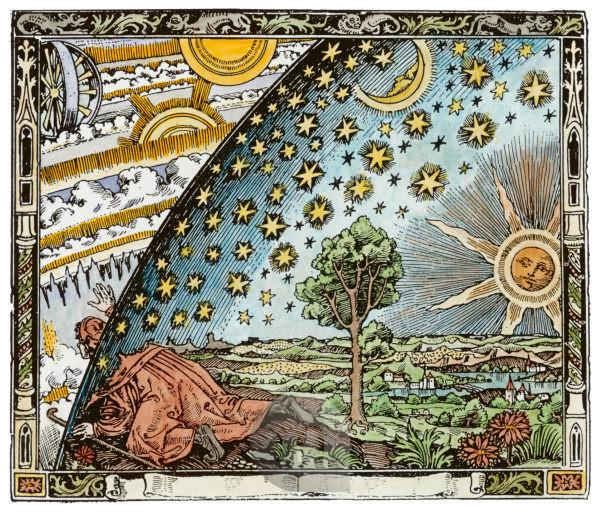
Posted on 05/10/2023 1:31:05 PM PDT by nickcarraway
The ‘music of the spheres’ was born from the effort to use numbers to explain the universe
An image of a white half circle at the bottom-center on a starry background. There are 8 arches spreading away from the circle. The Pythagoreans believed that the motions of the heavenly bodies, with just the right ratios of their distances from a central fire, made pleasant music — a concept that evolved into the “music of the spheres.”
If you’ve ever heard the phrase “the music of the spheres,” your first thought probably wasn’t about mathematics.
But in its historical origin, the music of the spheres actually was all about math. In fact, that phrase represents a watershed in the history of math’s relationship with science.
In its earliest forms, as practiced in ancient Egypt and Mesopotamia, math was mainly a practical tool for facilitating human interactions. Math was important for calculating the area of a farmer’s field, for keeping track of workers’ wages, for specifying the right amount of ingredients when making bread or beer. Nobody used math to investigate the nature of physical reality.
Not until ancient Greek philosophers began to seek scientific explanations for natural phenomena (without recourse to myths) did anybody bother to wonder how math would help. And the first of those Greeks to seriously put math to use for that purpose was the mysterious religious cult leader Pythagoras of Samos.
It was Pythagoras who turned math from a mere tool for practical purposes into the key to unlocking the mysteries of the universe. As the historian Geoffrey Lloyd noted, “The Pythagoreans were … the first theorists to have attempted deliberately to give the knowledge of nature a quantitative, mathematical foundation.”
(Excerpt) Read more at sciencenews.org ...
Not sure if this could apply to your ping list.
If its an effective tool for understanding reality, make it mandatory for every dumbass libtard...


Yep, it’s all ratios, and not just melody and harmony. You can express every common harmonic interval as a superposition of simple rhythms (for example, 3 beats per measure over 4 beats per measure is equivalent to a perfect fifth), which are sped up until the oscillations are within the range of human hearing.
How Pythagoras Learned From The Egyptians How to Turn Math Into a Tool For Understanding Reality. Opps, they left that part out of the history books ... sorry
It was all in the library at Alexandria. I think it burned down though.
Pythagoras studied for years under Egyptian priests in Egypt. The Library is a different matter. It was the Egyptians as far back as the Old Kingdom and likely even pre-dynastic that all of that figured out.
You don’t imagine that the Pyramids at Giza are just random piles of stones with no other significance?
Thanks nickcarraway. I'm tempted to milk this one for at least one other of the ping lists, but I won't.
Mark
Math is the white Man’s tool to keep blacks down.
But elevate Asians...
Let Pythagoras solve that riddle!
Interesting. I had music theory classes back in the 70s and I don’t remember anything like that. Not doubting you, I just don’t remember it being taught.
Did I miss something, or is this relatively new…
The harmonics part I remember. I don’t remember the rhythm part.

I don’t think this is anything new, it’s just not usually the focus of any music theory classes, as it is more of an interesting scientific fact and not quite so useful if you are learning composition or trying to analyze music. It’s the kind of thing you learn when you start to get down to the nitty gritty and look at the physical mechanics of music at the level of sounds waves and wave harmonics.
Here’s a page where someone took different rhythms and sped them up until you can hear the intervals they are equivalent to:
https://dantepfer.com/blog/?p=277
Disclaimer: Opinions posted on Free Republic are those of the individual posters and do not necessarily represent the opinion of Free Republic or its management. All materials posted herein are protected by copyright law and the exemption for fair use of copyrighted works.